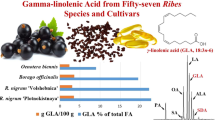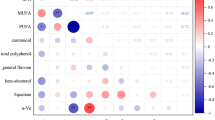Abstract
In the frame of SAFENUT AGRI GEN RES Action, which was a European strategy for the recovery, characterization and conservation of genetic resources, the fatty acids and the tocopherol profiles of a set of 75 hazelnut accessions were analyzed. The aim of this study was to assess the genetic differences among the European germplasm, contributing to the definition of nut quality in traditional European areas of cultivation. Significant differences were found between accessions for oil amount and contents of most fatty acids. As expected, monounsaturated fatty acids made up the largest portion (mean 80.85 %) followed by polyunsaturated fatty acids (10.70 %). The saturated ones were the minor components and accounted for only 8.43 % of the total fatty acids. On the basis of Student’s test, significant differences between the 2 years of harvest were found for fatty acid content, except for linoleic acid, the ratio of polyunsaturated, α-tocopherol and the stability index. When the oil content was studied in cultivars from the same site of cultivation, the mean values of the genetic pools from central Italy (60.8 %), Slovenia (59.3 %) and Portugal (58.2 %) showed highest values than those of cultivars grown in Greece (56.8 %), Spain (55.9 %) and France (51.5 %). A chemometric approach based on principal component and clustering analyses was developed to identify the most interesting cultivars for breeding programs.


Similar content being viewed by others
References
Alasalvar C, Shahidi F, Liyanapathirana CM, Ohshima T (2003) Turkish Tombul hazelnut (Corylus avellana L.). 1. Compositional characteristics. J Agric Food Chem 51:3790–3796
Alasalvar C, Amaral JS, Satir G, Shahidi F (2009) Lipid characteristics and minerals of native Turkish hazelnut essential varieties (Corylus avellana L.). Food Chem 113(4):919–925
Amaral JS, Casal S, Citova I, Santos A, Seabra RM, Oliveira BPP (2006a) Characterization of several hazelnuts (Corylus avellana L.) cultivars based on chemical, fatty acid and sterol composition. Eur Food Res Technol 222:274–280
Amaral JS, Cunha SC, Santos A, Alves MR, Seabra RM, Oliveira BP (2006b) Influence of cultivar and environment conditions on the triacylglycerol profile of hazelnut (Corylus avellana L.). J Agric Food Chem 54:449–456
Arena E, Campisi S, Fallico B, Maccarone E (2007) Distribution of fatty acids and phytosterols as a criterion to discriminate geographic origin of pistachio seeds. Food Chem 104(1):403–408
Bacchetta L, Di Giovanni B (2012) The enhancement of hazelnut and almond genetic resources through the European AGRI GEN RES SAFENUT Action. The ENEA experience as project coordinator. Rivista on line EAI N1:15–17
Bacchetta L, Avanzato D, Botta R, Boccacci P, Drogouti P, Metzidakis I, Rovira M, Silva AP, Solar A, Spera D, Di Giovanni B (2008) First results of SAFENUT: a European project for the preservation and utilization of Hazelnut local genetic resources. Acta Horticulturae 845:30–34
Bacchetta L, Spera D, Avanzato D, Botta R, Boccacci P, Di Giovanni B, Drogoudi P, Duval H, Metzidakis, I, Rovira M, Silva AP, Socias R, Solar A (2010) European Hazelnut and Almond genetic resources: results and perspectives of networking SAFENUT AGRI GEN RES activities. In: IHC Science and Horticulture for people—28th International Horticultural Congress, Lisboa (Portugal), 22–27 Aug Abstract vol 2, Symposia. p 546
Bacchetta L, Di Giovanni B, Rovira M, Spera D, Avanzato D, Botta R, Boccacci P, Drogoudi P, Duval H, Metzidakis I, Silva AP, Socias R, Solar A (2011) The AGRI GEN RES ‘SAFENUT’ Action: a European strategy for the preservation and utilization of hazelnut and almond genetic resources. Nucis N 15
Bacchetta L, Avanzato D, Di Giovanni B, Botta R, Boccacci P, Drogoudi P, Metzidakis I, Rovira M, Sarraquigne JP, Silva AP, Solar A, Spera D (2012) The re-organization of European hazelnut genetic resources in the SAFENUT (AGRI GEN RES) Project. VIII International Congress on Hazelnut Chile
Balta MF, Yarilgac T, Askin MA, Kuçuk M, Balta F, Ozrenk K (2006) Determination of fatty acid compositions, oil contents and some quality traits of hazelnut genetic resources grown in eastern Anatolia of Turkey. J Food Compos Anal 19:681–686
Boccacci P, Akkak A, Botta R (2006) DNA-Typing and genetic relationships among European hazelnut (Corylus avellana L.) cultivars using microsatellite markers. Genome 49:598–611
Boccacci P, Rovira M, Botta R (2008) Genetic diversity of hazelnut (Corylus avellana L.) germplasm in Northeastern Spain. HortScience 43(3):667–672
Botta R, Gianotti C, Me G (1997) Kernel quality in hazelnut cultivars and selections analysed for sugars, lipids and fatty acid composition. Acta Horticulturae 445:319–326
Brown AHD (1989) The case for core collections. In: Brown AHD, Frankel OH, Marshall DR, Williams JT (eds) The use of plant genetic resources. Cambridge University Press, Cambridge, Stralinger P, pp 135–156
Cantini C, Cimato A, Sani G (1999) Morphological evaluation of olive germplasm present in Tuscany region. Euphytica 109:173–181
Cristofori V, Ferramondo S, Bertazza G, Bignami C (2008) Nut and kernel traits and chemical composition of hazelnut (Corylus avellana L.) cultivars. J Sci Food Agric 88(6):1091–1198
Dietrich M, Traber MG, Jacques PF, Cross CE, Hu Y, Block G (2006) Does γ-tocopherol play a role in the primary prevention of heart disease and cancer? A review. J Am Coll Nutr 25(4):292–299
Drogoudi PD, Pantelidis G, Bacchetta L, De Giorgio D, Duval H, Metzidakis I, Spera D (2012) Protein and mineral nutrient contents in kernels from 72 sweet almond cultivars and accessions grown in France, Greece and Italy. Int J Food Sci Nutr. doi:10.3109/09637486.2010.523415
Erdogan V, Aygun A (2005) Fatty acid composition and physical properties of Turkish tree Hazelnuts. Chem Nat Compd 41(4):378–381
Font i Forcada C, Kodad O, Juan T, Estopañan G, Socias i Company R (2011) Genetic variability and pollen effect on the transmission of the chemical components of the almond kernel. Span J Agric Res 9(3):781–789
Fraser GE (2009) Vegetarian diets: what do we know of their effects on common chronic diseases? Am J Clin Nutr 89:1607S–1612S
Garcia JM, Agar IT, Streif J (1992) Fat content and fatty acid composition in individual seeds of pistachio varieties grown in Turkey. Gartenbauwissenschaft 57:130–133
Garcıa-Lopez C, Gran′e-Teruel N, Berenguer-Navarro V, Garcı′a-Garcı′a JE, Martı′n-Carratala ML (1996) Major fatty acid composition of 19 almond cultivars of different origins. A chemometric approach. J Agric Food Chem 46:963–967
Germain E, Sarraquigne JP (1997) Hazelnut training systems: comparison between three systems used on three varieties. Acta Horticulturae 445:237–245
Gurrieri F, Audergon JM, Albagnac G, Reich M (2001) Soluble sugars and carboxylic acids in ripe apricot fruit as parameters for distinguishing different cultivars: use of principle component analysis to characterize apricot fruit quality. Euphytica 117:183–189
Hu YX, Hanna MA (2010) Composition and oxidative stabilities of oils extracted from hybrid hazelnut grown in Nebrasca, USA. Int J Food Sci Tecnol 45:2329–2336
Iezzoni AF, Pritts MP (1991) Applications of principal components analysis to horticultural research. HortScience 26:334–338
Izquierdo NG, Aguirrez′abal LAN, Andrade FH, Cantarero MG (1985) Modelling the response of fatty acid composition to temperature in a traditional sunflower hybrid. Agron J 98:451–461
Kodad O, Socias i Company R (2006) Phenotypic correlation between some agrochemical traits of the almond kernel. Acta Horticulturae 726:259–264
Kodad O, Socias i Company R, Pratsd MS, Lopez Ortiz MC (2006) Variability in tocopherol concentrations in almond oil and its use as a selection criterion in almond breeding. J Hortic Sci Biotechnol 81(3):501–507
Kodad O, Estopañán T, Juan G, Molino F, Mamouni A, Messaoudi Z, Lahlou M, R. Socias i Company (2010) Plasticity and stability in the major fatty acid content of almond kernels grown under two Mediterranean climates. J Hortic Sci Biotechnol 85:381–386
Kodad O, Alonso JM, Espiau MT, Estopañán G, Socias i Company R (2011) Chemometric characterization of almond germplasm: compositional aspects involved in quality and breeding. J Am Soc Hortic Sci 136:273–281
Kornsteiner M, Wagner KH, Elmadfa I (2006) Tocopherols and total phenolics in 10 different nuts types. Food Chem 98:381–387
Lansari A, Iezzoni AF, Kester DE (1994) Morphological variation within collections of Moroccan almond clones and Mediterranean and North American cultivars. Euphytica 78:27–41
Lehmann EL (1975) Nonparametric: statistical method based on ranks. Holden-Day, San Francisco
Lotti G, Izzo R, Riu P (1985) Effects of climate on acid and sterol composition of olive oil. Riv Soc Ital Sci 11:126
Martı′nez-Calvo J, Gisbert AD, Alamar MC, Hernandorena R, Romero C, Lla′cer G, Badenes L (2008) Study of a germplasm collection of loquat (Eriobotrya japonica Lindl.) by multivariate ana lysis. Genet Resour Crop Evol 55:695–703
Mehlenbacher SA (1990a) Advances in hazelnut breeding. Annu Rep North Nut Grow Assoc 80:30–34
Mehlenbacher SA (1990b) Hazelnut varieties for the kernel market. In: Proceedings of Annual Meeting Nut Growers Society of Oregon, Washington and British Columbia, vol 75. p 59–66
Nikolic′ D, Rakonjac V, Milatovic′ D, Fotiric M (2010) Multivariate analysis of vineyard peach (Prunus persica (L.) Batsch.) germplasm collection. Euphytica 171:227–234
Özdemir M, Filiz Açkurt F, Kaplan M, Yıldız M, Löker M, Gürcan T, Biringen G, Okay A, Seyhan FG (2001) Evaluation of new Turkish hybrid hazelnut (Corylus avellana L.) varieties: fatty acid composition, α-tocopherol content, mineral composition and stability. Food Chem 73(4):411–415
Parcerisa J, Rafecas M, Castellote AI, Codony R, Ferràn A, Garcia J, Gonzalez C, Lopez A, Romero A, Boatella R (1995) Infuence of variety and geographical origin on the lipid fraction of hazelnuts (Corylus avellana L.) from Spain: III oil stability, tocopherol content and some mineral contents (Mn, Fe, Cu). Food Chem 53:71–75
Pershern AS, Breene WM, Lulai EC (1995) Analysis of factors influencing lipid oxidation in hazelnuts (Corylus spp.). J Food Process Preserv 19(1):9–26
Rovira M, Romero M, Clave J (1997) Clonal selection of Gironell and Negret hazelnut cultivars. Acta Hoticulturae 445:145–150
Silva AP, Santos A, Cavalheiro J, Ribeiro C, Santos F, Goncalves B (2007) Fruit chemical composition of six hazelnut cultivars grown in Portugal. J Appl Hortic 9:120–123
Sivakumar G, Bacchetta L (2005) Determination of natural vitamin E from Italian hazelnut leaves. Chem Nat Prod 41(6):654–656
Sivakumar G, Bacchetta L (2006) Alpha-Tocopherol from Italian hazelnut germoplasm. Chem Nat Compd 42(1):845–848
Sivakumar G, Bacchetta L, Gatti R, Zappa G (2005) HPLC screening of natural vitamin E from mediterranean plant biofactories a basic tool for pilot-scale bioreactors production of a-tocopherol’. J Plant Physiol 162:1280–1283
Skinner DZ, Bauchan GR, Auricht G, Hughes S (1999) A method for the efficient management and utilization of large germplasm collections. Crop Sci 39:1237–1242
Socias i Company R, Kodak O, Alonzo JM, Gradziel TM (2008) Almond quality: a breeding perspective. Hort Rev 34:197–238
Solar A, Štampar F (1997) First experiences with some foreign hazelnut cultivars (Corylus avellana L.) in Slovenia. Acta Horticulturae 445:83–89
Solar A, Štampar F (2011) Characterisation of selected hazelnut cultivars: phenology, growing and yielding capacity, market quality and nutraceutical value. J Sci Food Agric 91(7):1205–1212
Tombesi A, Preziosi P, Boco M (1994) Selection of Tonda Romana and Tonda di Giffoni cross pollinated hazelnut seedlings. Acta Horticolturae 351:119–122
Turcu E, Botu I (1997) Behaviour of some hazelnut varieties in the subcarpathian area of Oltenia-Romania. Acta Horticulturae 445:135–144
Xu YX, Hanna MA (2010) Evaluation of Nebraska hybrid hazelnuts: nut/kernel characteristics, kernel proximate composition, and oil protein properties. Ind Crops Prod 31:84–91
Xu YX, Hanna MA, Josiah SJ (2007) Hybrid hazelnut oil characteristics and its potential oleochemical application. Ind Crops Prod 26:69–76
Zacheo G, Capello MS, Gallo A, Santino A, Capello AR (2000) Changes associated with postharvest ageing in almond seeds. Lebensmittel-Wissenschaft und Tecnologie 33:415–423
Acknowledgments
The authors acknowledge the AGRI GEN RES Community Program (European Commission, Directorate-General for Agriculture and Rural Development, under Council Regulation (EC) No. 870/2004), for financial support. Many thanks to the traditional hazelnut growers of different countries (Spain, France, Greece, Italy, Portugal and Slovenia) associations, companies, researchers, and all the people who have contributed with materials included in the collections.
Author information
Authors and Affiliations
Corresponding author
Rights and permissions
About this article
Cite this article
Bacchetta, L., Aramini, M., Zini, A. et al. Fatty acids and alpha-tocopherol composition in hazelnut (Corylus avellana L.): a chemometric approach to emphasize the quality of European germplasm. Euphytica 191, 57–73 (2013). https://doi.org/10.1007/s10681-013-0861-y
Received:
Accepted:
Published:
Issue Date:
DOI: https://doi.org/10.1007/s10681-013-0861-y




